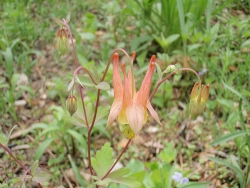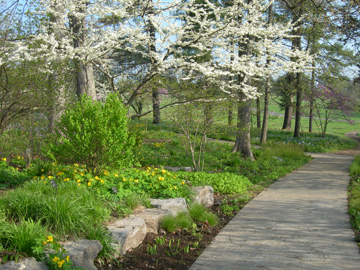By Cindy Gilberg
 Replacing a percent of high-maintenance lawn with a more sustainable low-maintenance landscape is a growing trend for the future. “The increased requests I get for assistance is proof that people are using more and more native plants each year, not fewer,” says Scott Woodbury, head of the Horticulture Department at Shaw Nature Reserve. He goes on to say an increasing number of people “are turning to native plants to landscape their homes, churches, businesses, and public parks. Compared to traditional high-maintenance landscapes, people are switching to native landscapes because they are more cost-effective to maintain and are good for the environment.”
Replacing a percent of high-maintenance lawn with a more sustainable low-maintenance landscape is a growing trend for the future. “The increased requests I get for assistance is proof that people are using more and more native plants each year, not fewer,” says Scott Woodbury, head of the Horticulture Department at Shaw Nature Reserve. He goes on to say an increasing number of people “are turning to native plants to landscape their homes, churches, businesses, and public parks. Compared to traditional high-maintenance landscapes, people are switching to native landscapes because they are more cost-effective to maintain and are good for the environment.”
Even so, there still exists some misconceptions regarding use of native plants in the landscape. Some novices feel as if by planting natives their garden will suddenly become ‘wild’. Native plants simply represent a viable, alternative list of reliably hardy plants that can be integrated into any landscape. A plant list does not dictate the design style, rather, it is the gardener who decides his or her style and needs, adjusting the plant list accordingly. Likewise, selling your lawn mower does not automatically produce a native garden or habitat. Scott calls this the “shock and awe” approach and it is likely to produce a weed patch and draw the attention of neighbors (rightly so!), resulting in weed ordinance problems. Having worked with cities, weed ordinances and homeowners, Scott adds “Weed ordinance issues are tricky. Most of them originate from a complaining neighbor and not a city inspector, so rule number one is to be neighborly. Rule number two is to start small and expand on your successes. Rule number three is to learn the basics of garden design. Most homeowners who get in trouble break one of these three rules.”

First of all, consider that the word ‘garden’ includes in most of its definitions the word ‘cultivate’. This implies that human hands are at work, manipulating and controlling the garden environment to some degree. Therefore, the element of intent goes hand in hand with planning a well-designed garden. If you are having some ordinance issues or you are not happy with your garden, review the following design principles and strive to include at least a few. A little planning goes a long way in creating an attractive, low-maintenance native landscape.
Line functions as one of the most important concepts in the landscape. Think of pathways, bed edging, fencing or mowed turf as examples of line. Line visually guides the eye and points to a focal point. Focal points can be as simple as your front door, a bench, a sculpture or a planted urn. Small water features are also welcome sights and need not be elaborate. A line leading to nowhere and a view without a focal point are disappointing.

Hardscaping is an indispensable part of the landscape that serves to reinforce line and unify the view. As a design becomes more naturalistic and loose, the use of strong lines becomes essential. Stone is an element that is both visually strong and versatile enough to be useful in all design styles, from informal to formal and from traditional to naturalistic landscapes. Weathered stones used in a way that emulates the natural outcroppings so familiar in the Midwest add a sense of place to the scene. When choosing stone for paths and steps, edging, walls or patios, be sure to use stone of the same kind and a similar color. Unmatched and jumbled stone will give a confused and disorganized look rather than acting to unify the garden. Wood complements stone and can be included by adding a deck, some fencing, an arbor, a bench or even a gazebo.
When choosing which plants to combine in a design, always keep the idea of contrast in mind. Foliar contrast is what will prevent a planting from appearing weedy. Combine bold textured plants with fine textured ones alternately so that each is accentuated by its neighbor. A garden full of fine textured plants and devoid of weeds will appear weedy regardless, simply from a lack of foliar contrast.

Some simple maintenance practices strengthen the look of intention. Always maintain clean edges around the plantings. This can be in the form of a mass ground cover planting such as prairie dropseed in sunny spots or wild ginger in shady spots – there are many choices for plants that can be used. A well-maintained mowed grass edge or a stone pathway is just as effective in keeping a tidy boundary. Another positive practice is to use shredded leaves or bark mulch in the beds to help control weeds and to add that finished look.
One extra tip would be to do an angle cut tip-pruning in spring on taller plants, especially those along the edges of beds. This will add some depth to the bed while encouraging a more compact growth habit. Don’t hesitate to do a spring tip-pruning on any of the taller, summer and fall blooming perennials such as asters, hibiscus or goldenrods to create the same effect. A certain level of general maintenance, as with any landscape, will always send a message of the gardener’s intention to cultivate the space.
Cindy Gilberg, horticulturist and Missouri native, founded and ran the garden center at Gilberg Perennial Farms with her husband Doug for 28 years, also teaching classes and workshops on gardening and garden design. She now focuses on garden design, consulting and teaching, and also works part-time in the Whitmire Wildflower Garden at Shaw Nature Reserve, emphasizing the use of native plants in home landscaping.
